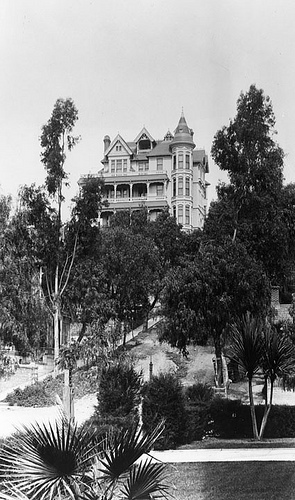
At the turn of the 20th Century, no building dominated Bunker Hill like the Crocker Mansion. Perched high at the corner of Third and Olive, the imposing 3-story Victorian structure overlooked the emerging metropolis for a mere 22 years. Though its reign over Bunker Hill was short, the Crocker Mansion remains an indelible part of early Los Angeles history.
Designed by architect John Hall and erected in 1886, the ornate residence was built by Mrs. Margaret E. Crocker at a cost of $45,000 (a little over a million in today’s dollars). Margaret was the widow of Edwin Bryant Crocker, a California Supreme Court Justice, who with his brother, Charles, amassed a fortune in the railroad industry. Following her husband’s death in 1875, Mrs. Crocker became a known social and civic leader who had donated the family’s impressive art collection to the city of Sacramento. At the time she commissioned the Los Angeles residence, Mrs. Crocker owned homes in Sacramento, Lake Tahoe, San Francisco and New York.

In 1887, the mansion became the center of a scandal when Alma Ashe, Margaret Crocker’s granddaughter, was kidnapped from the residence.

Two-year-old Alma was the daughter of Amy Crocker and playboy Robert Porter Ashe, who had previously scandalized the family in 1882 by eloping. Rumored to have married Miss Crocker for the family riches, Amy soon grew weary of her groom, who spent plenty of time and money at the racetrack. The marriage soon went south and in April 1887, Ashe marched into the Crocker Mansion and marched out with his daughter, who was being watched by relatives while her mother and grandmother were out of town. Ashe and the child holed up in the St. Elmo Hotel on Main Street for a couple of days until a judge formally ordered he hand the child over to the Crockers. Ashe claimed he was protecting his daughter from her unfit mother, while Amy claimed her husband was attempting to gain leverage over her by imprisoning the child. Ultimately, grandma took Alma to live in Europe until she was old enough to decide which parent she preferred to live with. The Ashe-Crocker union was officially dissolved a few months later, and Amy (later going by Aimee) would ignore the incident altogether in her 1936 memoir ”¦And I”™d Do it Again.

In 1891, the Crocker Mansion became a boarding house/hotel, though far ritzier than the faded Bunker Hill boarding rooms of the 1940s/50s. Though Mrs. Crocker was no longer residing there, she still maintained ownership of the stately structure that played host to many a member of society”™s elite. Even as a commercial property, rooms were always advertised as located in the “Crocker Mansion.”

Construction on the Third Street tunnel began in 1900, and Mrs. Crocker filed a petition claiming that the mansion was endangered by the street tunnel which was “unsafe, improperly constructed and a veritable death trap.” According to the Los Angeles Times, “the walls of her house are settling, the foundations giving way and the plaster is falling off”¦Unless something is done, the building is liable to topple into a hole.” The house never did topple and was alive and well in 1902 when Angels Flight began operating and dropping riders off practically on the Crocker doorstep.


Margaret Crocker died in 1901 and possession of the mansion was assumed by her children, except for hell-cat Aimee who had been left out of the will. The mansion was sold in 1905 for $50,000 along with the land that ran 120 feet on Olive and 150 feet on Third, down to Clay Street. The Crocker Mansion subsequently closed its doors as a boarding house and plans were soon drawn up to renovate the residence for use as social quarters for the Elk”™s, who were putting up a new building on the eastern portion of the property. When the frame of the “old” house was deemed too weak, the Crocker Mansion was scheduled for demolition, to be replaced by a reinforced concrete structure.
The Victorian building was razed in June 1908 and the cornerstone for the Elk”™s Annex was laid the following September.
All photos courtesy of the Los Angeles Public Library Photo Collection.

